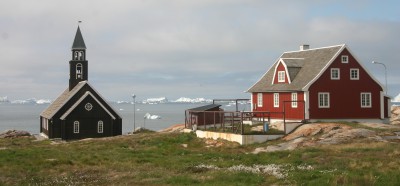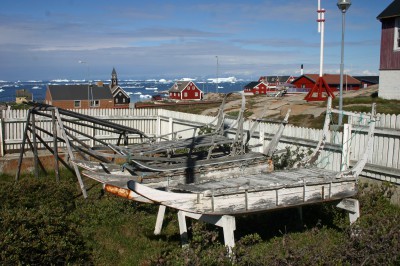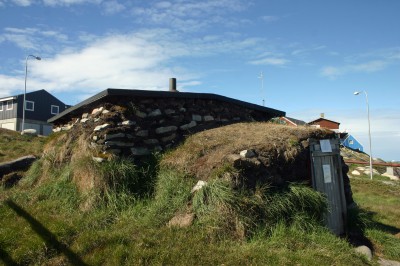
The next
stop on my journey is the town of Ilulissat (previously called Jakobshavn).
With a population of about 5000 people it is approximately ten times as big as
Kangerlussuaq – and at least ten times as pretty, with its many colourful
houses nestled among the rocks overlooking the iceberg-filled fjord.


One of
Ilulissat’s claims to fame is the Ilulissat Icefjord, a UNESCO World Heritage
Site, which I will get back to in a later blog. Icebergs from the glacier
feeding into the fjord dot the water and create a fascinating, ever-changing
view.
 This is what the fjord and the icebergs look like at midnight:
This is what the fjord and the icebergs look like at midnight: 
There are
also approximately 1500 furry sled dogs throughout Ilulissat. The dogs are kept
for winter transportation and hunting. The breed is Greenland Dog, which has
its origins in Siberia thousands of years ago. Via North America it came to
Greenland with the Thule people about 1000 years ago. There were dogs in
Greenland even 4000 years ago, but these dogs were not necessarily the forefathers
of the present breed. I believe research is being carried out to study their origins.

During the
summer, the dogs in Ilulissat are out of work and seem bored. They spend their
days sleeping, eating and getting fat and lazy. I bet they have just as hard a
time on their first winter sled trips as I have getting in shape at my first
autumn fitness class after a long, lazy summer.

Dogs over
five months must be kept chained for the safety of small children. These dogs
are not family pets but working dogs and while many of them are friendly, some
of them can be rather feral. They have bred for hardiness, not cuteness. The young
dogs are allowed to roam freely, but they do not go far. They have a very
strong group mentality and keep close to their flock (and their dinner). There
is a small group of sled dogs just outside my hostel. I say hello to them daily
but keep my distance as instructed.
Ilulissat
was the home of the Danish/Greenlandic polar explorer Knud Rasmussen who lived
from 1879 to 1933. His perhaps greatest achievement was to travel by sled dog
and visit Inuit settlements all across the Arctic from Greenland to Siberia. He
was the first European to cross the Northwest passage by sled dog. He proved
that the various Arctic people were related by a common language, lifestyle and
way of thinking. If you have not heard of this great and fascinating man, I
suggest you read more about him.
The house in which he was born has been made into a wonderful museum that overlooks the ice-filled water. Here is a view from the museum showing traditonal sleds – a type which is still in use today (when not replaced by snowscooters):
 The museum also has a traditional peat hut, which is quite cosy inside:
The museum also has a traditional peat hut, which is quite cosy inside:

